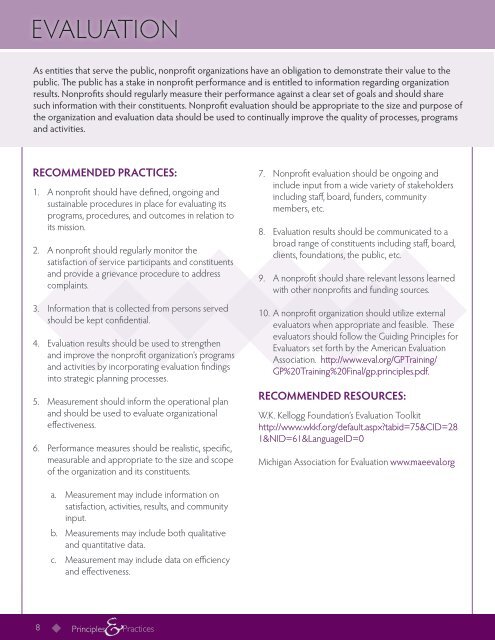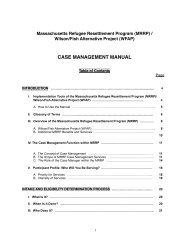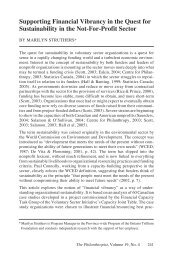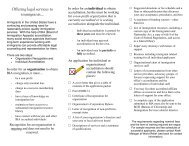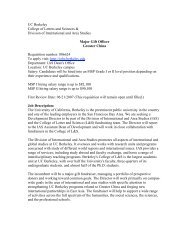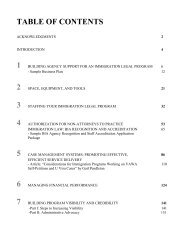Principles & Practices for Nonprofit - NNAAC
Principles & Practices for Nonprofit - NNAAC
Principles & Practices for Nonprofit - NNAAC
Create successful ePaper yourself
Turn your PDF publications into a flip-book with our unique Google optimized e-Paper software.
EVALUATION<br />
As entities that serve the public, nonprofit organizations have an obligation to demonstrate their value to the<br />
public. The public has a stake in nonprofit per<strong>for</strong>mance and is entitled to in<strong>for</strong>mation regarding organization<br />
results. <strong>Nonprofit</strong>s should regularly measure their per<strong>for</strong>mance against a clear set of goals and should share<br />
such in<strong>for</strong>mation with their constituents. <strong>Nonprofit</strong> evaluation should be appropriate to the size and purpose of<br />
the organization and evaluation data should be used to continually improve the quality of processes, programs<br />
and activities.<br />
RECOMMENDED PRACTICES:<br />
1.<br />
2.<br />
3.<br />
4.<br />
5.<br />
6.<br />
8<br />
A nonprofit should have defined, ongoing and<br />
sustainable procedures in place <strong>for</strong> evaluating its<br />
programs, procedures, and outcomes in relation to<br />
its mission.<br />
A nonprofit should regularly monitor the<br />
satisfaction of service participants and constituents<br />
and provide a grievance procedure to address<br />
complaints.<br />
In<strong>for</strong>mation that is collected from persons served<br />
should be kept confidential.<br />
Evaluation results should be used to strengthen<br />
and improve the nonprofit organization’s programs<br />
and activities by incorporating evaluation findings<br />
into strategic planning processes.<br />
Measurement should in<strong>for</strong>m the operational plan<br />
and should be used to evaluate organizational<br />
effectiveness.<br />
Per<strong>for</strong>mance measures should be realistic, specific,<br />
measurable and appropriate to the size and scope<br />
of the organization and its constituents.<br />
a.<br />
b.<br />
c.<br />
Measurement may include in<strong>for</strong>mation on<br />
satisfaction, activities, results, and community<br />
input.<br />
Measurements may include both qualitative<br />
and quantitative data.<br />
Measurement may include data on efficiency<br />
and effectiveness.<br />
& <strong>Principles</strong> <strong>Practices</strong><br />
7.<br />
8.<br />
9.<br />
<strong>Nonprofit</strong> evaluation should be ongoing and<br />
include input from a wide variety of stakeholders<br />
including staff, board, funders, community<br />
members, etc.<br />
Evaluation results should be communicated to a<br />
broad range of constituents including staff, board,<br />
clients, foundations, the public, etc.<br />
A nonprofit should share relevant lessons learned<br />
with other nonprofits and funding sources.<br />
10. A nonprofit organization should utilize external<br />
evaluators when appropriate and feasible. These<br />
evaluators should follow the Guiding <strong>Principles</strong> <strong>for</strong><br />
Evaluators set <strong>for</strong>th by the American Evaluation<br />
Association. http://www.eval.org/GPTraining/<br />
GP%20Training%20Final/gp.principles.pdf.<br />
RECOMMENDED RESOURCES:<br />
W.K. Kellogg Foundation’s Evaluation Toolkit<br />
http://www.wkkf.org/default.aspx?tabid=75&CID=28<br />
1&NID=61&LanguageID=0<br />
Michigan Association <strong>for</strong> Evaluation www.maeeval.org


